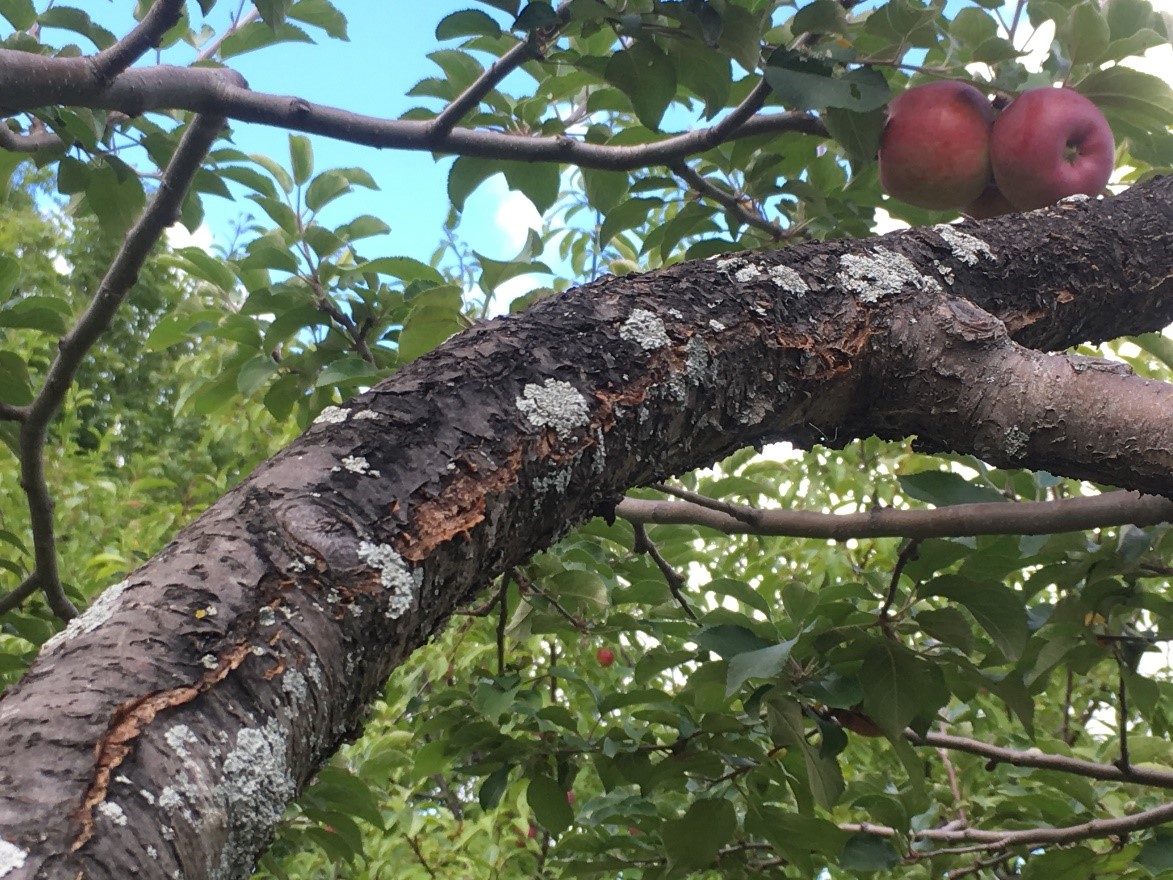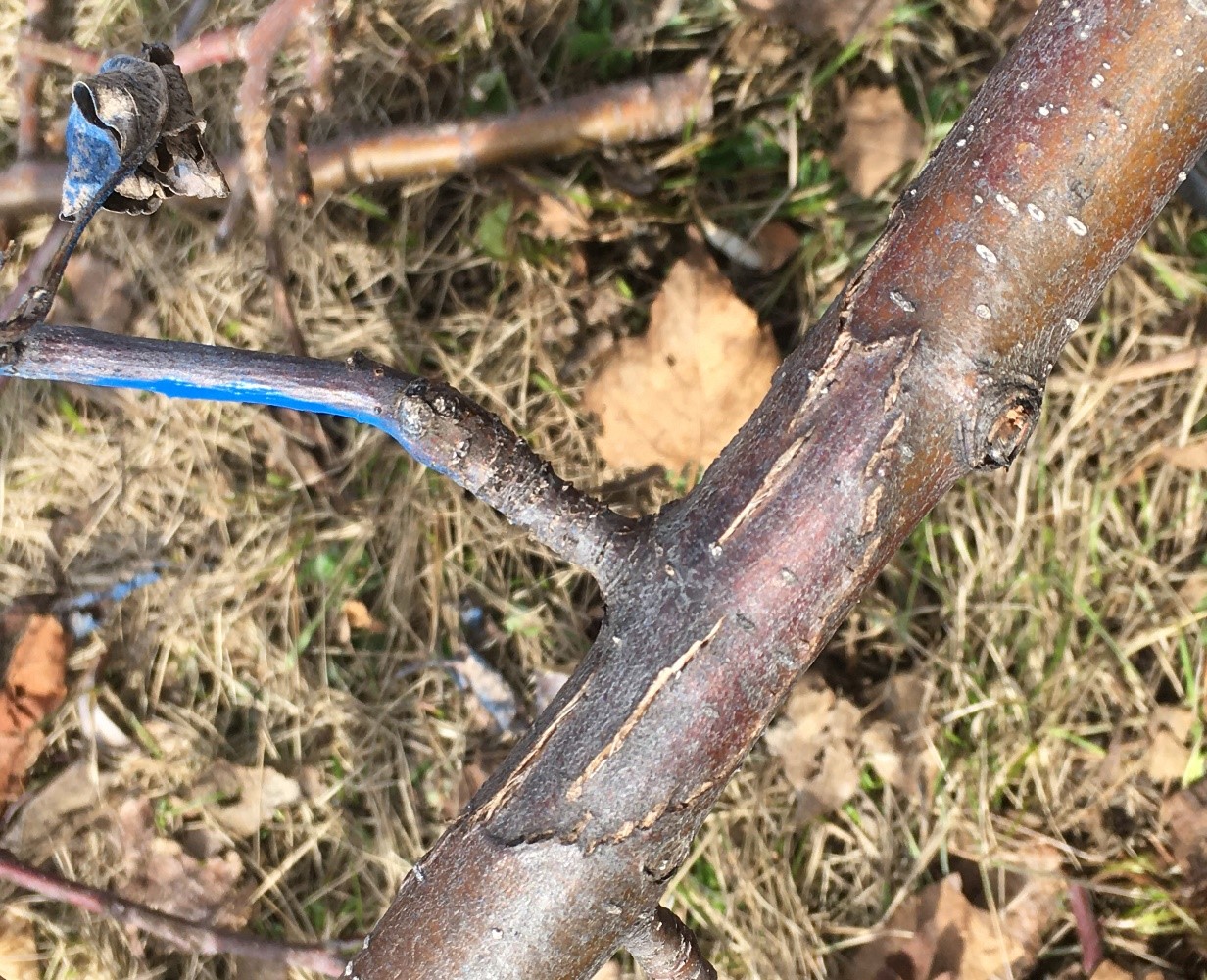Apple Tree Diseases
Pruning work continues in the CREC orchard and is starting to pick up speed. I started pruning our apple trees a few weeks ago when there was still one foot of snow cover. After it melted, I switched to the ladder to finish up. Now, I’m finishing the shrubs.
Last summer, Dr. Jim Walla pointed out black rot on one of our ‘Hazen’ apple trees. It was on a top branch that rose to the northeast, which meant that it was fully exposed to warming by afternoon sunlight. That warming during cold periods in late winter most likely cracked the branch and let in the black rot fungus. If I had painted that branch with white latex paint, it could have prevented the frost cracks. In the picture, you will notice the scaly bark and black soot of the fungal spores. I have to say I generally ignore the apple trees after pruning and fruit thinning. I assumed the black area was from normal sooty fungus that develops around some pruned areas. (Are those black rot spores, too?!) And ‘Hazen’ normally has scaly, old bark. So, the development of this infection was a combination of my ignorance and ambivalence. I pruned the branch out last summer and I am keeping an eye out for more.
 Black rot damage on ‘Hazen’ apple tree branch, Summer 2019.
Black rot damage on ‘Hazen’ apple tree branch, Summer 2019.
Black rot can affect the leaves, fruit and branches of trees. It generally enters through injuries such as frost cracks, hail damage and mower blight. But it also enters via fire blight-injured sites. So, after fire blight, be on the lookout for this fungal problem.
More black rot information: https://www.ag.ndsu.edu/cpr/forestry/diseases-of-apple-trees-black-rot
We also had fire blight in the ‘Sweet 16’ trees in 2019, a cultivar that is normally quite resistant to this bacterial infection. There was a lot of it and I did not remove it during the season. Last fall I spray painted all the affected branches to mark them and then removed them with 2020 pruning. On one tree, I had to remove a couple full branches, and this is unfortunate because ‘Sweet 16’ is so vigorous that any pruning causes even more vegetative growth. This cultivar is tasty. If you want one, try to get it on dwarfing rootstock such as M-26 or Bud9. That will suppress its wild tendencies and cause it to fruit more.
 Fire blight canker at the base of an affected ‘Sweet 16’ shoot.
Fire blight canker at the base of an affected ‘Sweet 16’ shoot.
Fire blight is a bacterial infection that arrives at the trees via insects such as bees. In spring, cloudy liquid droplets ooze out of infected spots, insects pick it up on their bodies and then transmit the inoculum to visited flowers. Dew, mist and rain carry the bacteria down into the flower where the bacteria then grows and moves in the vascular tissue. Fire blight is becoming a very extensive problem in the East, affecting both orchards and homeowners.
More information on fire blight: https://www.ag.ndsu.edu/horticulture/fireblight
A good video for pruning basics: https://www.ag.ndsu.edu/publications/lawns-gardens-trees/basic-guidelines-for-pruning-trees-and-shrubs
General apple tree info: https://www.ag.ndsu.edu/drappletree
Kathy Wiederholt
Kathy.Wiederholt@ndsu.edu
Northern Hardy Fruit Project Manager


